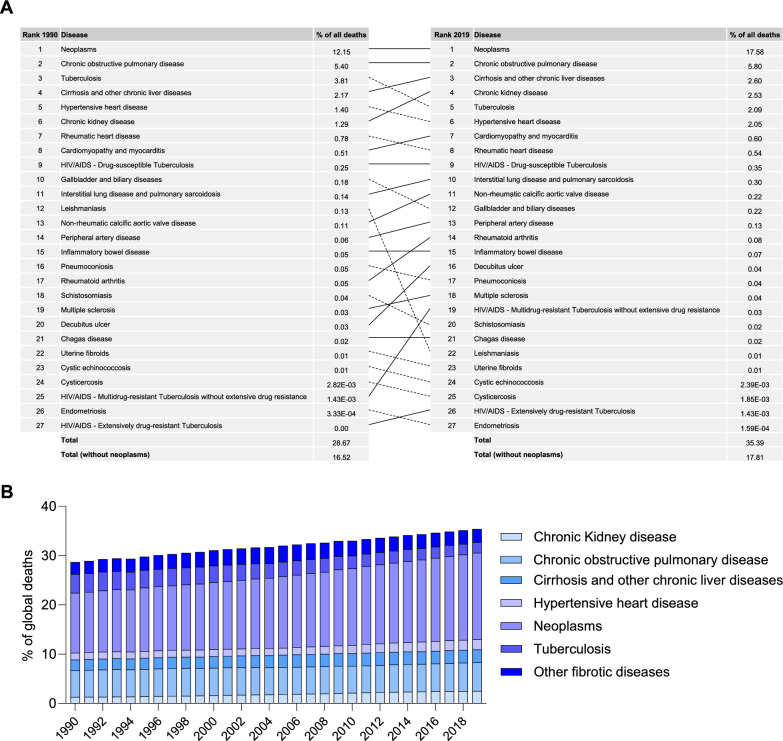To the Editor,
Fibrosis, characterized by the excessive production and accumulation of extracellular matrix (ECM) proteins, is an integral part of numerous chronic diseases affecting vital organs such as the lungs, liver, heart, and kidneys [1]. Despite the diversity in their etiological underpinnings and clinical presentations, these disorders all lead to a common process of tissue remodeling and scarring. This results in the deterioration of organ structure, functional impairment, and ultimately organ failure, often requiring transplantation. While there has been a long-standing notion that fibrotic diseases might account for up to 45% of worldwide deaths, this estimate has lacked solid epidemiological backing. To address this knowledge gap, we turned to the 2019 Global Burden of Disease (GBD) study (https://www.healthdata.org) [2], aiming to uncover the actual impact of fibrotic diseases on global mortality.
From the myriad causes of death documented in the GBD, we specifically focused on conditions connected to ECM remodeling (Fig. 1A). Based on these data, a conservative estimate posits that fibrotic diseases contributed to 16.5% of all global deaths in 1990, and this percentage steadily increased over time to 17.8% in 2019 (Fig. 1A). However, emerging insights indicate that the majority of neoplasms should also be categorized as fibrotic disorders, as fibrosis plays a key role in tumor growth and metastasis [3–5]. When accounting for neoplasms, excluding acute lymphoid leukemia and acute myeloid leukemia, the overall impact of fibrotic diseases on global deaths in 1990 was 28.7%, which subsequently rose to 35.4% in 2019 (Fig. 1A, B). Among all fibrotic disorders, neoplasms and chronic obstructive pulmonary disease consistently ranked as the primary contributors to global mortality during this period (Fig. 1A). In contrast, the impact of various infectious diseases declined over time. For instance, tuberculosis, a significant contributor in 1990, saw its contribution nearly halved by 2019 (Fig. 1A, B), reflecting changing patterns in the global disease landscape over the years.
Fig. 1.
Impact of Fibrotic Diseases on Global Mortality from 1990 to 2019. A Selected causes of death and their ranking in 1990 and 2019, based on their percentage contribution to global deaths. B Trend of percentage of global deaths attributable to fibrotic diseases from 1990 to 2019
While the impact of fibrotic disorders on global mortality might be smaller than previously estimated, and we recognize that certain deaths involve factors beyond ECM remodeling and fibrosis, it remains evident that fibrotic diseases still contribute significantly to global mortality. This underscores the necessity for sustained research efforts aimed at developing effective antifibrotic treatments, as this critical need remains largely unaddressed.
Acknowledgements
Not applicable.
Abbreviations
- ECM
Extracellular matrix
- GBD
Global Burden of Disease
Author contributions
Conceptualization: HAMM, RN. Formal analysis: all authors. Visualization: HAMM, CM, OP-R. Writing—original draft: HAMM, CM. Writing—review & editing: all authors. Supervision: HAMM, RN. All authors read and approved the final manuscript.
Funding
This study was supported by the Lundbeck Foundation (R368-2021-726).
Availability of data and materials
All data generated or analysed during this study are included in this published article.
Declarations
Ethics approval and consent to participate
Not applicable.
Consent for publication
Not applicable.
Competing interests
The authors declare that they have no competing interests.
Footnotes
Publisher's Note
Springer Nature remains neutral with regard to jurisdictional claims in published maps and institutional affiliations.
References
- 1.Rockey DC, Bell PD, Hill JA. Fibrosis—a common pathway to organ injury and failure. N Engl J Med. 2015;372(12):1138–1149. doi: 10.1056/NEJMra1300575. [DOI] [PubMed] [Google Scholar]
- 2.Diseases GBD, Injuries C. Global burden of 369 diseases and injuries in 204 countries and territories, 1990–2019: a systematic analysis for the Global Burden of Disease Study 2019. Lancet. 2020;396(10258):1204–1222. doi: 10.1016/S0140-6736(20)30925-9. [DOI] [PMC free article] [PubMed] [Google Scholar]
- 3.Yamauchi M, Barker TH, Gibbons DL, Kurie JM. The fibrotic tumor stroma. J Clin Invest. 2018;128(1):16–25. doi: 10.1172/JCI93554. [DOI] [PMC free article] [PubMed] [Google Scholar]
- 4.Piersma B, Hayward MK, Weaver VM. Fibrosis and cancer: a strained relationship. Biochim Biophys Acta Rev Cancer. 2020;1873(2):188356. doi: 10.1016/j.bbcan.2020.188356. [DOI] [PMC free article] [PubMed] [Google Scholar]
- 5.Boulter L, Bullock E, Mabruk Z, Brunton VG. The fibrotic and immune microenvironments as targetable drivers of metastasis. Br J Cancer. 2021;124(1):27–36. doi: 10.1038/s41416-020-01172-1. [DOI] [PMC free article] [PubMed] [Google Scholar]
Associated Data
This section collects any data citations, data availability statements, or supplementary materials included in this article.
Data Availability Statement
All data generated or analysed during this study are included in this published article.



